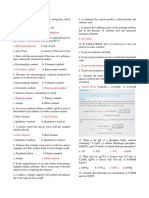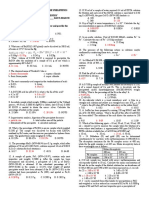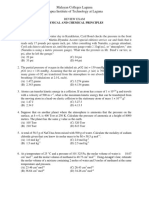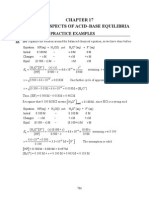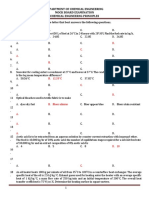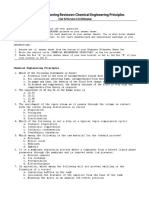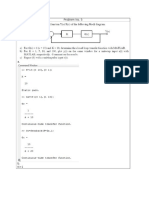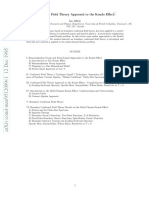TECHNOLOGICAL INSTITUTE OF THE PHILIPPINES MANILA CH342 ANALYTICAL CHEMISTRY NAME:__________________________________ DATE:MARCH 13, 2014 ENGR. LORRAINE CARRILLO INSTRUCTIONS: Encircle the correct answer and provide the solutions for problem solving questions
1. The conjugate acid of NH
3
a. HOH b. NH
4
+
c. OH
-
d. NH
2
2. In a dilute solution, the concentration of water is a. 5.56 M b. 10.5 M c. 55.6 M d. NOTG 3. What mass of Ba(IO3)2 (487 g/mol) can be dissolved in 500.0 mL of water at 25°C? Given the ffg: a. 0.104g b. 0.178 g c. 0.245 g d. 0.328g 4. What volume of 0.12M BaCl2 is required to precipitate the BaSO4 after the oxidation of a sample of 0.1 g of ore which is approximately 80 % FeS2? A.11.1 mL B. 20.3 mL C. 22.4 mL D. NOTG
5. The chemical name of Turnbull’s blue is
a. ferrous ferricyanide c. cuprous chloride b. ferric ferrocyanide d. cupric chloride 6. The most commonly used reagent in the standardization of acids a. K
2
SO
4
b. borax c. BaCl
2
d. Na
2
CO
3
7. A 0.0722M acid has pH of 3.11, what is the Ka of this acid? a. 4.2 x 10
-6
b. 8.4 x 10
-6
c. 8.4 x 10
-7
d. 1.2 x 10
-7
8. An iodide sample which weighs 3.000g is analyzed by the Volhard process; 49.50 mL 0.2000 M AgNO3 is added, and 6.50 mL 0.1000 M KSCN is needed to titrate the excess silver. Calculate the percentage of iodide in the sample. A. 25.36% B. 32.18% C. 39.13% D. NOTG 9. In gravimetric analysis, digestion of the precipitate decreases a. particle size b. total surface area of the particle c. filterability of the precipitate d. adsorbed materials 10. What is the percentage of Fe3O4 in an ore sample which weighed 0.5350 g? The sample was dissolved by fusion with KHSO4, oxidized by Br2 water, and the iron was precipitated as hydrous ferric oxide. The ignited ferric oxide weighed 0.5178 g. A. 85.23% B. 88.42% C.93.55% D. NOTG 11. The percentage MnO
2
(MW=86.94) in a 0.5 g sample, which after addition of 50 ml of 0.10N FeSO
4
solution required 16 ml of 0.08 N K
2
Cr
2
O
7
solution for back titration is A. 16.17 B. 32.34 C. 48.51 D. 64.68 12. A sample of pyrite, FeS
2
(MW=119.97), contains only inert impurities and weights 0.5080 g. After the sample has been decomposed and dissolved, a precipitate of 1.561 g of BaSO
4
(MW=233.40) is obtained. If the calculated percentage of S (MW=32.06) in the sample is 42.21% what weight of ignited precipitate would have been obtained if the Fe (MW=55.85) in the solution had been precipitated as Fe (OH)
3
and ignited as Fe
2
O
3
(MW=159.7)? A. 0.2670 g B. 0.217 g C. 0.2985 g D. 0. 3025 g 13. If 50 ml of a sample of water required 6.4 ml of EDTA solution for titration and each ml of the EDTA solution is equivalent to 0.40 mg Ca (MW=40), the ppm CaCO
3
(MW=100) hardness is A. 320 B. 220 C. 360 D. 128 14. Ksp of AgCl at room temperature is 1 x 10
10
. Calculate the Ag
+
ion concentration in ppm in a 0.01M NaCl solution. A. 0.001079 B. 0.0024 C. 0.0035 D. 0.0042 15. In an acidic solution, 25ml of 0.021M KMnO
4
oxidize Fe
2+
to Fe
3+
. Calculate the mass of Fe
2+
(55.85g) oxidized a. 14.66mg b. 25.32mg c. 2.55mg d. 146.6mg 16. The presence of the following cations in solutions maybe confirmed by conducting flame tests, except: a. Ba
+2
b. Na
+1
c. Ca
+2
d. Ni
+2
17. In 100ml of 0.2M NH
3
solution was added 50 ml of 0.3M NH
4
Cl solution. If Kb of NH
3
is 1.75 x 10
-5
, calculate the pH of the final mixture a. 5.62 b. 8.38 c. 5.92 d. NOTG 18. Find the pH of a solution made by diluting one drop (0.04 mL) of 0.10 N HCl to 10 liters. A. 6.37 B. 7.24 C. 8.14 D. 8.55 19. A 0.7500 g sample of an alloy steel yielded on electrolysis 0.1532 g of a mixed deposit of Co and Ni. This is dissolved, and the precipitated nickel dimethylglyoxine (NiC8H14N4O4) weighs 0.3560 g. What is the percentage of the Ni in the alloy? A a. 9.64% Ni; b. 10.79%Ni c. 12.43% Ni d. 13.79%Ni 20. An indicator which is a weak monobasic acid is blue in a strongly acid solution and yellow in a strongly basic one. If K
ind
is 10
–
10
, what is the pH when 40% of the indicator is in the yellow form? a. 7.82 b. 8.82 c. 9.82 d. 10.82 21. A buffer has been prepared by mixing 250 mg NH4Cl and 200 mL of 0.1 M NH3 solution. What is the pH of this after 10 mM HCl has been added? The addition of the acid dilutes the mixture to 250 mL. a. 9.85 b. 9.09 c. 10.85 d. 11.09 22. Which of the following pipets
–
10 ml, 20 ml, 25 ml, 50 ml, 100 ml
–
should be used to measure the sample taken for titration of a water whose total hardness is approximately 900 ppm CaCO3 if the EDTA solution available has a CaCO3 titer of 0.8385 mg? a. 10 ml, b. 20 ml, c. 25 ml, d. 50 ml, 23
–
24. Palladium (II) and gold (III) can be determined simultaneously by reactions with methiomeprazine (C19H24N2S2). The absorption maximum for the Pd complex occurs at 480 nm, while for the gold complex is at 635 nm. Molar absorptivity data at these wavelengths are as follows: Molar Absorptivity 480 nm 635 nm Pd complex 3.55 x 10
3
5.64 x 10
2
Gold complex 2.96 x 10
3
1.45 x 10
4
A 25.0 mL sample was treated with excess methiomeprazine and subsequently diluted to 50 mL. Calculate the molar concentration of Pd and Au in the sample if the diluted solution has an absorbance of 0.533 at 480 nm and 0.590 at 635 nm when measured in a 1-cm cell. Au 23. a. 3.60 x 10
-5
M b. 5.60 x 10
-5
M c. 4.60 x 10
-5
M d. 6.60 x 10
-5
M Pd a. 1.20 x 10
-4
M b. 2.20 x 10
-4
M c. 1.60 x 10
-5
M d. 2.60 x 10
-5
M 25. I
–
can be separated from other halides by precipitation as PdI2 and weighed as such or reduced in a current of H2 to Pd. A 0.5000-g sample of KI and NaCl and inert impurities gave a precipitate of mixed silver halides which weighed 0.8000 g. A 0.2000-g sample yielded 0.04250 g metallic palladium. Find the percentage of NaCl in the sample. A.66.10% B. 27.18% C. 69.21% D. NOTG











